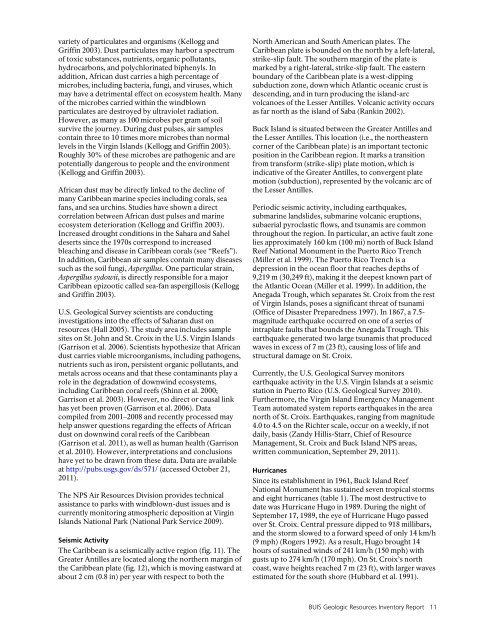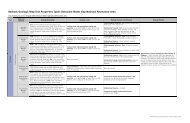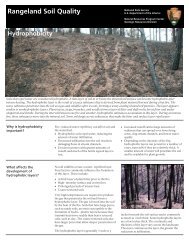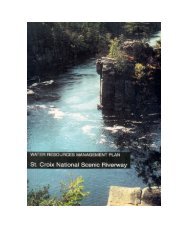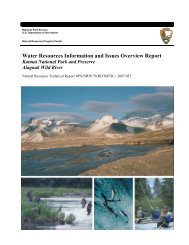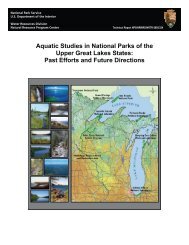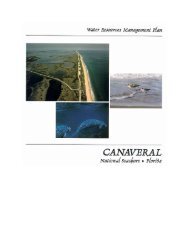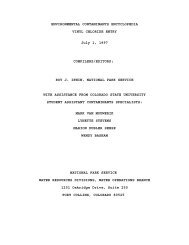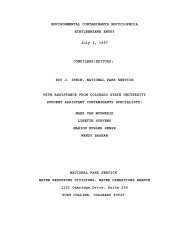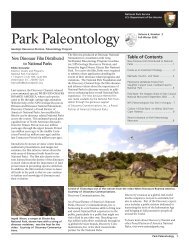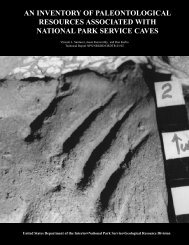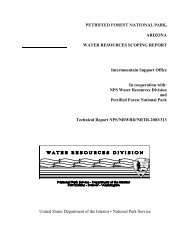Buck Island Reef National Monument Geologic Resources Inventory
Buck Island Reef National Monument Geologic Resources Inventory
Buck Island Reef National Monument Geologic Resources Inventory
Create successful ePaper yourself
Turn your PDF publications into a flip-book with our unique Google optimized e-Paper software.
variety of particulates and organisms (Kellogg and<br />
Griffin 2003). Dust particulates may harbor a spectrum<br />
of toxic substances, nutrients, organic pollutants,<br />
hydrocarbons, and polychlorinated biphenyls. In<br />
addition, African dust carries a high percentage of<br />
microbes, including bacteria, fungi, and viruses, which<br />
may have a detrimental effect on ecosystem health. Many<br />
of the microbes carried within the windblown<br />
particulates are destroyed by ultraviolet radiation.<br />
However, as many as 100 microbes per gram of soil<br />
survive the journey. During dust pulses, air samples<br />
contain three to 10 times more microbes than normal<br />
levels in the Virgin <strong>Island</strong>s (Kellogg and Griffin 2003).<br />
Roughly 30% of these microbes are pathogenic and are<br />
potentially dangerous to people and the environment<br />
(Kellogg and Griffin 2003).<br />
African dust may be directly linked to the decline of<br />
many Caribbean marine species including corals, sea<br />
fans, and sea urchins. Studies have shown a direct<br />
correlation between African dust pulses and marine<br />
ecosystem deterioration (Kellogg and Griffin 2003).<br />
Increased drought conditions in the Sahara and Sahel<br />
deserts since the 1970s correspond to increased<br />
bleaching and disease in Caribbean corals (see “<strong>Reef</strong>s”).<br />
In addition, Caribbean air samples contain many diseases<br />
such as the soil fungi, Aspergillus. One particular strain,<br />
Aspergillus sydowii, is directly responsible for a major<br />
Caribbean epizootic called sea-fan aspergillosis (Kellogg<br />
and Griffin 2003).<br />
U.S. <strong>Geologic</strong>al Survey scientists are conducting<br />
investigations into the effects of Saharan dust on<br />
resources (Hall 2005). The study area includes sample<br />
sites on St. John and St. Croix in the U.S. Virgin <strong>Island</strong>s<br />
(Garrison et al. 2006). Scientists hypothesize that African<br />
dust carries viable microorganisms, including pathogens,<br />
nutrients such as iron, persistent organic pollutants, and<br />
metals across oceans and that these contaminants play a<br />
role in the degradation of downwind ecosystems,<br />
including Caribbean coral reefs (Shinn et al. 2000;<br />
Garrison et al. 2003). However, no direct or causal link<br />
has yet been proven (Garrison et al. 2006). Data<br />
compiled from 2001–2008 and recently processed may<br />
help answer questions regarding the effects of African<br />
dust on downwind coral reefs of the Caribbean<br />
(Garrison et al. 2011), as well as human health (Garrison<br />
et al. 2010). However, interpretations and conclusions<br />
have yet to be drawn from these data. Data are available<br />
at http://pubs.usgs.gov/ds/571/ (accessed October 21,<br />
2011).<br />
The NPS Air <strong>Resources</strong> Division provides technical<br />
assistance to parks with windblown-dust issues and is<br />
currently monitoring atmospheric deposition at Virgin<br />
<strong>Island</strong>s <strong>National</strong> Park (<strong>National</strong> Park Service 2009).<br />
Seismic Activity<br />
The Caribbean is a seismically active region (fig. 11). The<br />
Greater Antilles are located along the northern margin of<br />
the Caribbean plate (fig. 12), which is moving eastward at<br />
about 2 cm (0.8 in) per year with respect to both the<br />
North American and South American plates. The<br />
Caribbean plate is bounded on the north by a left-lateral,<br />
strike-slip fault. The southern margin of the plate is<br />
marked by a right-lateral, strike-slip fault. The eastern<br />
boundary of the Caribbean plate is a west-dipping<br />
subduction zone, down which Atlantic oceanic crust is<br />
descending, and in turn producing the island-arc<br />
volcanoes of the Lesser Antilles. Volcanic activity occurs<br />
as far north as the island of Saba (Rankin 2002).<br />
<strong>Buck</strong> <strong>Island</strong> is situated between the Greater Antilles and<br />
the Lesser Antilles. This location (i.e., the northeastern<br />
corner of the Caribbean plate) is an important tectonic<br />
position in the Caribbean region. It marks a transition<br />
from transform (strike-slip) plate motion, which is<br />
indicative of the Greater Antilles, to convergent plate<br />
motion (subduction), represented by the volcanic arc of<br />
the Lesser Antilles.<br />
Periodic seismic activity, including earthquakes,<br />
submarine landslides, submarine volcanic eruptions,<br />
subaerial pyroclastic flows, and tsunamis are common<br />
throughout the region. In particular, an active fault zone<br />
lies approximately 160 km (100 mi) north of <strong>Buck</strong> <strong>Island</strong><br />
<strong>Reef</strong> <strong>National</strong> <strong>Monument</strong> in the Puerto Rico Trench<br />
(Miller et al. 1999). The Puerto Rico Trench is a<br />
depression in the ocean floor that reaches depths of<br />
9,219 m (30,249 ft), making it the deepest known part of<br />
the Atlantic Ocean (Miller et al. 1999). In addition, the<br />
Anegada Trough, which separates St. Croix from the rest<br />
of Virgin <strong>Island</strong>s, poses a significant threat of tsunami<br />
(Office of Disaster Preparedness 1997). In 1867, a 7.5-<br />
magnitude earthquake occurred on one of a series of<br />
intraplate faults that bounds the Anegada Trough. This<br />
earthquake generated two large tsunamis that produced<br />
waves in excess of 7 m (23 ft), causing loss of life and<br />
structural damage on St. Croix.<br />
Currently, the U.S. <strong>Geologic</strong>al Survey monitors<br />
earthquake activity in the U.S. Virgin <strong>Island</strong>s at a seismic<br />
station in Puerto Rico (U.S. <strong>Geologic</strong>al Survey 2010).<br />
Furthermore, the Virgin <strong>Island</strong> Emergency Management<br />
Team automated system reports earthquakes in the area<br />
north of St. Croix. Earthquakes, ranging from magnitude<br />
4.0 to 4.5 on the Richter scale, occur on a weekly, if not<br />
daily, basis (Zandy Hillis-Starr, Chief of Resource<br />
Management, St. Croix and <strong>Buck</strong> <strong>Island</strong> NPS areas,<br />
written communication, September 29, 2011).<br />
Hurricanes<br />
Since its establishment in 1961, <strong>Buck</strong> <strong>Island</strong> <strong>Reef</strong><br />
<strong>National</strong> <strong>Monument</strong> has sustained seven tropical storms<br />
and eight hurricanes (table 1). The most destructive to<br />
date was Hurricane Hugo in 1989. During the night of<br />
September 17, 1989, the eye of Hurricane Hugo passed<br />
over St. Croix. Central pressure dipped to 918 millibars,<br />
and the storm slowed to a forward speed of only 14 km/h<br />
(9 mph) (Rogers 1992). As a result, Hugo brought 14<br />
hours of sustained winds of 241 km/h (150 mph) with<br />
gusts up to 274 km/h (170 mph). On St. Croix’s north<br />
coast, wave heights reached 7 m (23 ft), with larger waves<br />
estimated for the south shore (Hubbard et al. 1991).<br />
BUIS <strong>Geologic</strong> <strong>Resources</strong> <strong>Inventory</strong> Report 11


